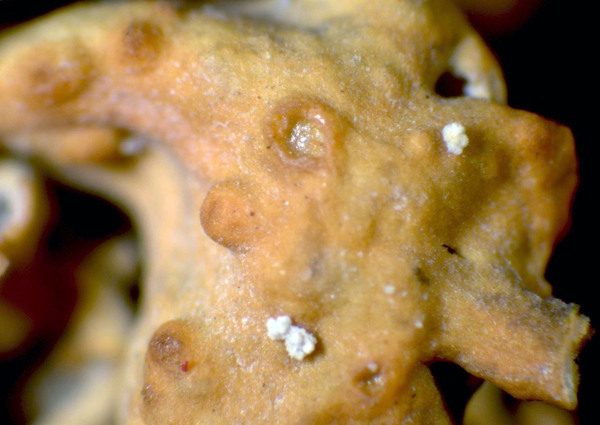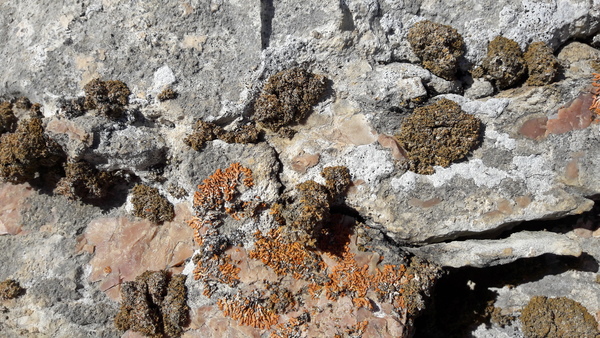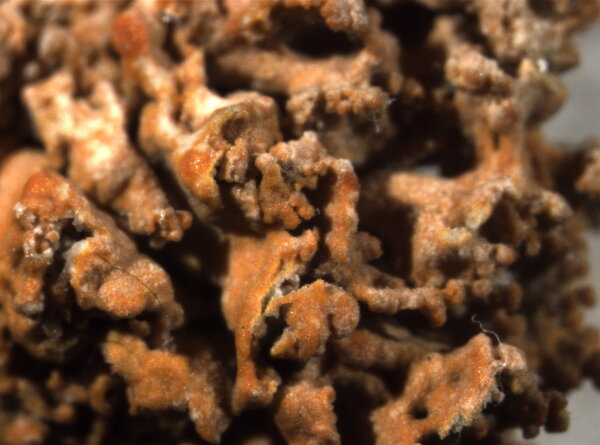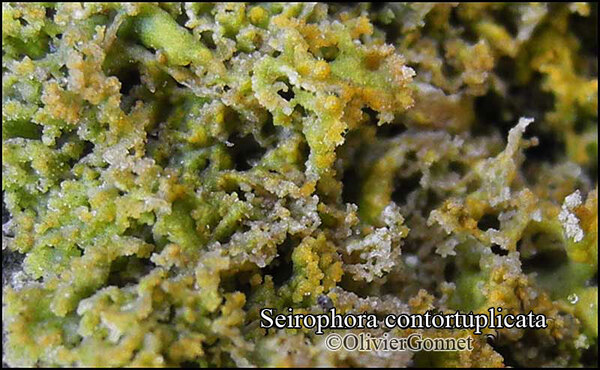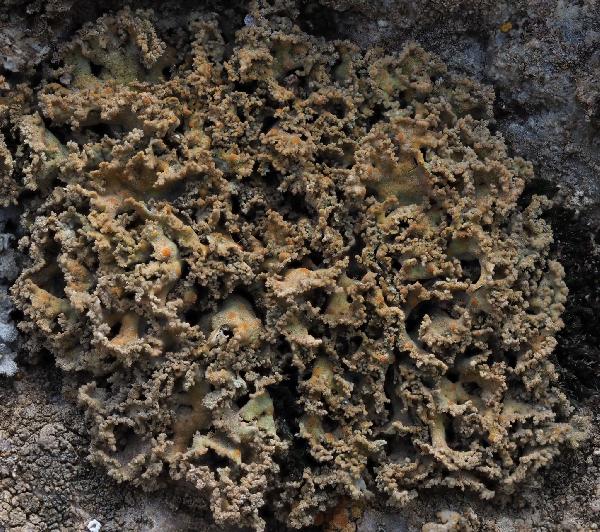Seirophora contortuplicata (Ach.) Frödén
in Frödén & Lassen, Lichenologist, 36: 29, 2004. Basionym: Parmelia contortuplicata Ach. - Syn. Meth. Lich.: 210, 1814.
Synonyms: Teloschistes contortuplicatus (Ach.) Clauzade & Rondon; Xanthaptychia contortuplicata (Ach.) S. Y. Kondr. & S. Ravera; Xanthoria contortuplicata (Ach.) Boistel
Distribution: N - Frl, Ven (Caniglia & al. 1999, Nascimbene & Caniglia 2000, Nascimbene 2004), TAA (Nascimbene 2004, Nascimbene & al. 2004, 2004b, 2022), Lomb, Piem, VA (TSB s.n.), Emil (Fariselli & al. 2020), Lig (TSB 33362). C - Marc (Nimis & Tretiach 1999), Umb (Ravera & al. 2003), Abr (Nimis & Tretiach 1999, Gheza & al. 2021), Sar (B - ex herb. Grummann 5474).
Description: Thallus subfruticose to subfoliose, up to 1.5 cm tall, forming small, densely branched masses, the lobes fragile, flattened or usually convex, adpressed to slightly ascending, 0.5-2 mm wide, mostly irregularly branched, attached by a basal holdfast and with short lateral lobes, the tips of secondary branches sometimes granulose-blastidiate. Upper surface more or less deep orange, but often grey-orange to grey in shade-forms and in older specimens, smooth or finely short-haired, especially at lobe tips; lower surface pale grey to yellow at lobe tips, often cracked exposing the medulla, with hyphal strands forming a reticulate pattern. Upper cortex of longitudinally arranged hyphae; medulla interrupted by hyphal strands with algae; lower cortex prosoplectenchymatous, with thin patches of medulla exposed where the cortex is missing. Apothecia very rare, lecanorine, laminal and subterminal, often stipitate, 1-3 mm across, with a dark orange, at first strongly concave then flat disc and a thick, raised thalline margin. Epithecium orange, K+ purple-red, hymenium and hypothecium colourless. Asci 8- spored, clavate, functionally unitunicate, apically thickened with a broad internal beak, the inner part of apex and external cap I+ blue, Teloschistes-type. Ascospores 2-celled, polarilocular, hyaline, oblong to narrowly ellipsoid, (10.5-)11-15(-17) x 6-8(-9) µm, the equatorial thickening (“septum”) 1.5-2.5 µm. Pycnidia large, projecting, laminal or subterminal, orange to reddish orange, to 0.3 mm wide. Conidia hyaline, simple, ellipsoid when young, narrowly ellipsoid to bacilliform when mature, 3-4 x 1.5-2 µm. Photobiont chlorococcoid. Spot tests: thallus K+ purple red, C-, KC-, P-. Chemistry: parietin (major), fallacinal, teloschistin, and parietinic acid (all minor), and emodin (minor). Note: on south-facing surfaces protected from rain (e.g. under overhangs) of calciferous rocks in the mountains. Not uncommon in the Alps and locally frequent along the eastern slopes of the Central Apennines.
Growth form: Fruticose
Substrata: rocks
Photobiont: green algae other than Trentepohlia
Reproductive strategy: mainly asexual, by soredia, or soredia-like structures (e.g. blastidia)
Subcontinental: restricted to areas with a dry-subcontinental climate (e.g. dry Alpine valleys, parts of Mediterranean Italy)
In underhangs rarely wetted by rain
Commonnes-rarity: (info)
Alpine belt: rare
Subalpine belt: rather rare
Oromediterranean belt: extremely rare
Montane belt: very rare
Submediterranean belt: absent
Padanian area: absent
Humid submediterranean belt: absent
Humid mediterranean belt: absent
Dry mediterranean belt: absent
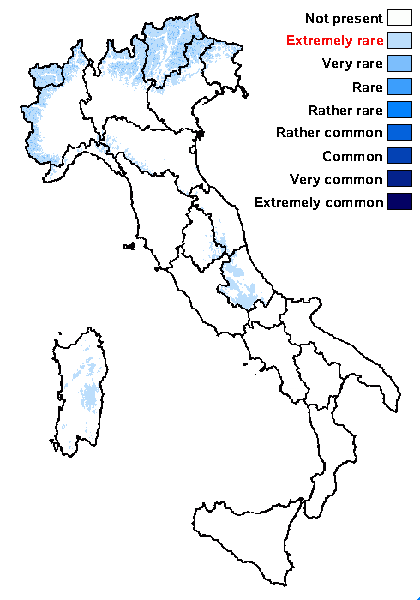
Predictive model
Herbarium samples


P.L. Nimis; Owner: Department of Life Sciences, University of Trieste
Herbarium: TSB (23761)
2001/12/11


P.L. Nimis; Owner: Department of Life Sciences, University of Trieste
Herbarium: TSB (23761)
2001/12/11
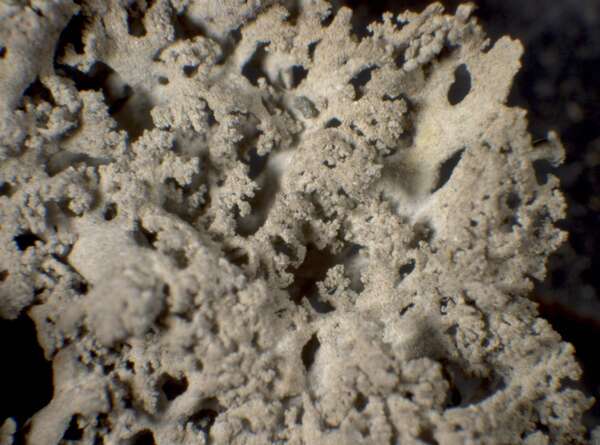

P.L. Nimis; Owner: Department of Life Sciences, University of Trieste
Herbarium: TSB (34906)
2001/12/11
a grey shade-form


Juri Nascimbene - CC BY-SA 4.0; Owner: ITALIC - Dyades Project - Dept. of Life Sciences, University of Trieste
Italy, Trentino-Alto Adige, Bolzano/Bozen, Sciliar/Schlern
2007
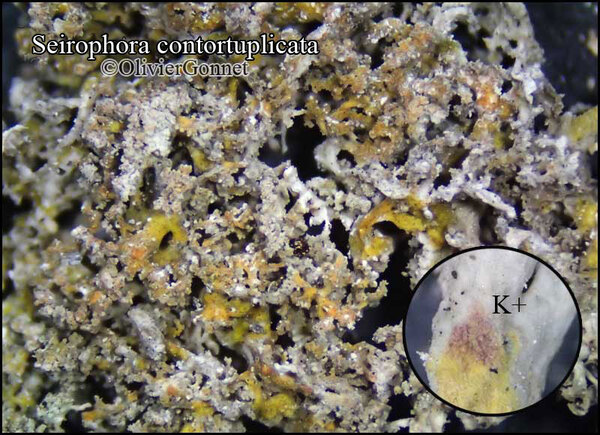
Courtesy Danièle et Olivier Gonnet - Source: https://www.afl-lichenologie.fr/Photos_AFL/Photos_AFL_S/Text_S/Seirophora_contortuplicata.htm
France, session AFL 2014 dans la vallée de l'Ubaye - Alpes de Haute-Provence
Growth form: Fruticose
Substrata: rocks
Photobiont: green algae other than Trentepohlia
Reproductive strategy: mainly asexual, by soredia, or soredia-like structures (e.g. blastidia)
Subcontinental: restricted to areas with a dry-subcontinental climate (e.g. dry Alpine valleys, parts of Mediterranean Italy)
In underhangs rarely wetted by rain
Commonnes-rarity: (info)
Alpine belt: rare
Subalpine belt: rather rare
Oromediterranean belt: extremely rare
Montane belt: very rare
Submediterranean belt: absent
Padanian area: absent
Humid submediterranean belt: absent
Humid mediterranean belt: absent
Dry mediterranean belt: absent

Predictive model
| Herbarium samples |


P.L. Nimis; Owner: Department of Life Sciences, University of Trieste
Herbarium: TSB (23761)
2001/12/11


P.L. Nimis; Owner: Department of Life Sciences, University of Trieste
Herbarium: TSB (23761)
2001/12/11


P.L. Nimis; Owner: Department of Life Sciences, University of Trieste
Herbarium: TSB (34906)
2001/12/11
a grey shade-form


Juri Nascimbene - CC BY-SA 4.0; Owner: ITALIC - Dyades Project - Dept. of Life Sciences, University of Trieste
Italy, Trentino-Alto Adige, Bolzano/Bozen, Sciliar/Schlern
2007

 INDEX FUNGORUM
INDEX FUNGORUM
 GBIF
GBIF
 DOLICHENS
DOLICHENS
